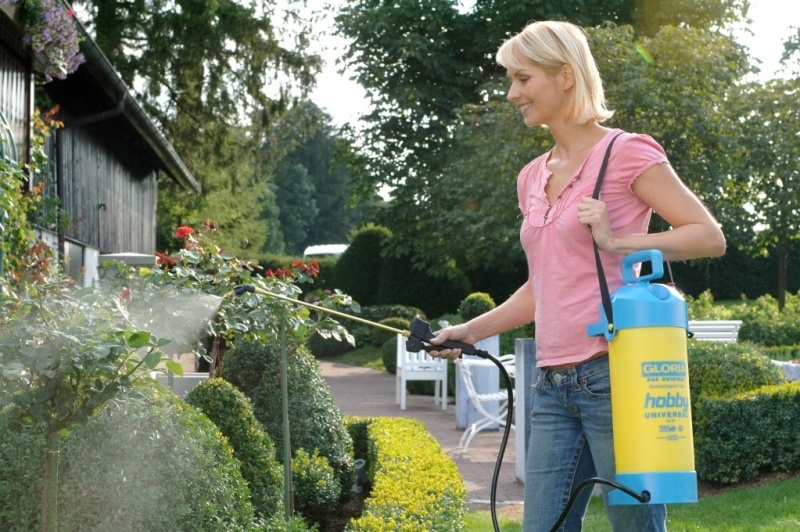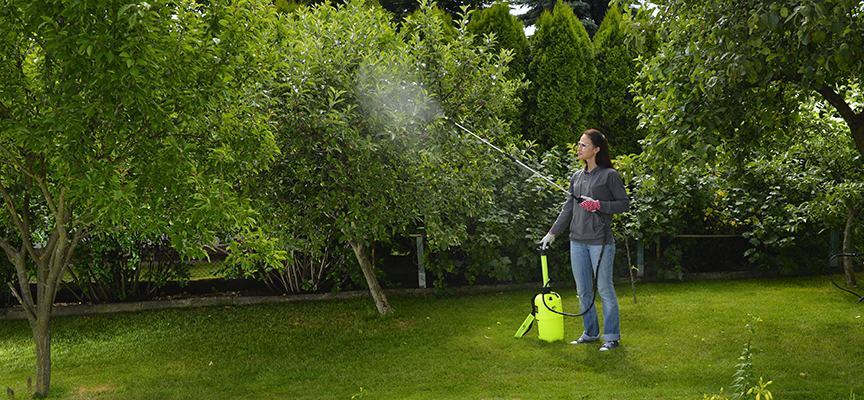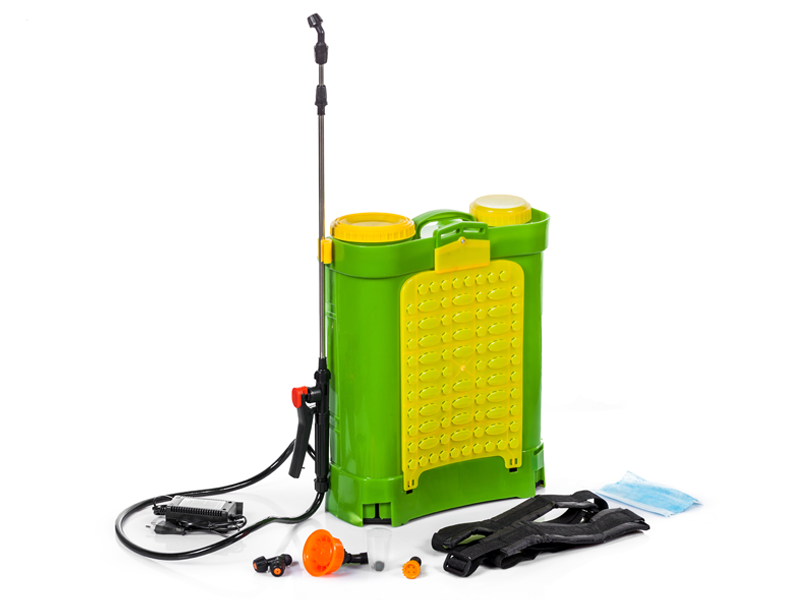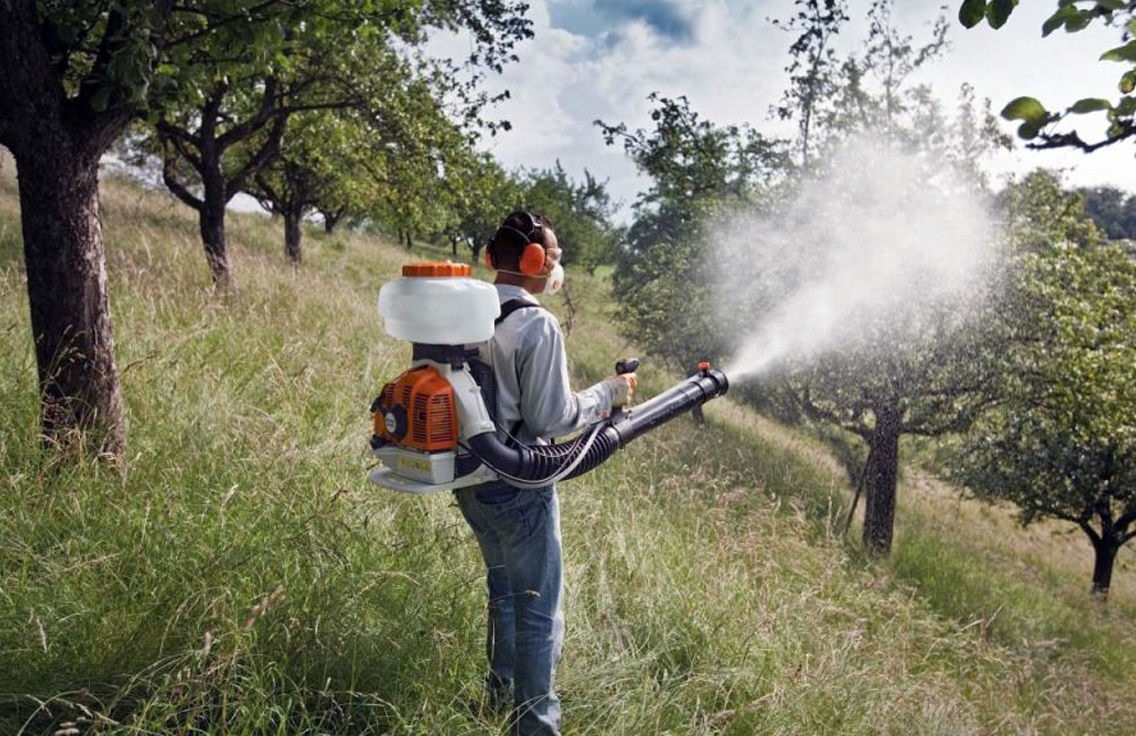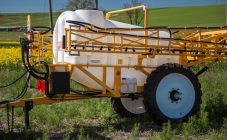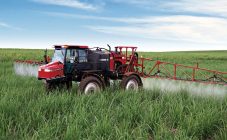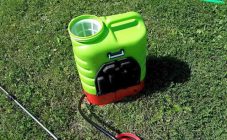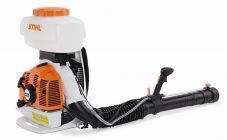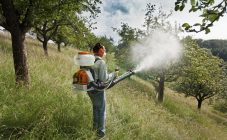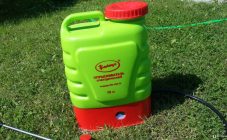Content:
Sprayers belong to the category of equipment used in the garden, in summer cottages, personal plots, on the territories of farms. A garden sprayer helps to treat plants and trees, with its help they clear the plantations of weeds.
The use of this technique in the garden makes it possible to process the most difficult places in terms of access. On request, you can purchase various types of sprayers equipped with blowers, you can buy a spray gun, watering cans instead of more efficient tools. Their choice is very diverse.
Types of garden sprayers
Plants, in addition to basic agrotechnical measures, need additional care. They need to be treated against pests and diseases, sprayed with liquid herbicides, and foliar top dressing.
To this end, gardeners and gardeners resort to using sprayers to treat plants in the presence of lesions. They can easily cope with such garden pests as beetles and insects. Able to help overcome various types of spore and putrefactive infections.
The units act as sprayers for professional use.
They are presented in a wide range and differ, depending on the principle of operation, power supply, technical characteristics. They can move on wheels and dress behind their backs in the manner of a knapsack. They can be supplemented with a 2.2 m long telescopic universal garden sprayer called beetle. Their volume is also different and ranges from 2 to 20 liters. According to the principle of action, they are classified into manual, pump, diesel, battery (electric).
Manual lever sprayers
This type of sprayer is considered a summer cottage version of the sprayer.
It is most popular with summer residents. It is used mainly in everyday life, but it is also good for working in greenhouses, greenhouses, flower shops. Hand-held sprayers are versatile: they can be used to spray liquids in the care of plants. In addition, they are suitable for the treatment of other objects and surfaces, for example, for disinfection of premises.
The principle of operation is mechanical: they are started manually and require muscle work. They are equipped with plastic containers with a volume of 10-12 liters, so there is no need to stop work to add working solution. The sprayer is easy to carry as it weighs only 4.3 kg and is secured to the back with straps. To start, a lever is mounted, a removable rod, if necessary, can be removed by replacing it with a longer or telescopic one. With the help of a membrane pump, a working pressure of 4 atmospheres is created in the apparatus.
The spray mode is adjustable: the spray will turn into a foggy state if you change the nozzle to operate the sprayer in a different mode.
The material from which the container is made is not susceptible to the action of aggressive substances, they do not pose any threat to it. In this case, the temperature should not exceed the thermometer mark + 40 ° С.
A light household indoor flower sprayer with a volume of only a few liters is a good option. Benefits: No battery, fuel or other power sources are required to operate.
The disadvantages include the weight of the unit when filled. When processing large plots, it causes hand fatigue.
Pump sprayers
They are of three types:
- manual
- shoulder;
- wheeled.
The volume of the tank of a pump (piston) device of the Quasar type ranges from 3 to 12 liters. The principle of operation consists in the presence of a pump mounted in the lid and creating a pressure of 3-4 atmospheres. Below is a hose (1-1.5 meters long). It is connected to a tube and a nozzle tip. The sprayer is also equipped with a handle and a lever. The shutter button at the top of the vessel is used for long processing times. When the pressure drops, it is pumped up with a lever handle and started to work again.
Advantages: convenient, makes it possible to process about 30 acres of area in one step. Durable when used correctly. Various design solutions are embodied in it, they are also worn behind the back, therefore such models are called knapsack models.
Disadvantages: high price, heavy weight of a full tank and the need to pump up pressure.
Battery models
This type of spray is used on large garden beds. The main condition for functioning is the presence of a battery, a power source. It can be recharged by connecting to the mains supply for a period of about 5 hours.
Cordless sprayers are equipped with a tank with a volume of 5 to 20 liters. They are distinguished by their mobility. No need to stock up on gasoline and oil for spraying. Compared to manual ones, they do not require additional efforts, but with a full tank they are heavy. The problem can be solved by filling the tank with solution only partially.
The kit consists of a 1 m long telescopic stainless steel spray tube. The device is equipped with a motor speed controller. A built-in voltmeter monitors battery charging. Various nozzles are used to ensure efficient processing. The voltage generated by the battery is supplied to the pump for efficient operation of the 12V sprayer. One charge is enough to work in automatic mode for 6 hours. In the presence of pauses, the operating time increases.
The use of an electric sprayer for a vegetable garden or garden wins, when compared with manual options, the advantages are obvious:
- high efficiency and productivity.
- lack of noise;
- the presence of a system that regulates the pressure level;
- saving time: no need to remove the backpack to pump up pressure;
- small dimensions;
- eliminates the need for stress on the arms.
Although this variety is more expensive, it is interesting as an almost perfect tool.
Gasoline machines
They are equipped with an internal combustion engine, during operation it makes noise, consumes gasoline or diesel fuel. Such a sprayer is good for trees and plants, with its help it is much easier to carry out treatments. One of the varieties of this type is a motor sprayer, equipped with a two-stroke type of engine. Due to this, a sufficiently powerful air flow is created in it, which directs the mixture to the object for spraying.
Petrol sprayers usually have an engine with a power range of 1-6 horsepower. If a motor with a power of more than 4 hp is installed on the unit, then it is classified as a professional model. For a fuel-powered sprayer, a lightweight and powerful two-stroke unit is considered the best option. The presence of another pump makes the processing of tall trees available.If it is absent, it is also possible to process trees that reach a height of 6 to 8 m.
The accessible area is within a radius of 15 meters. This is a significant benefit, but there are other benefits:
- Saving chemicals consumption several times due to high-quality spraying;
- Increasing the speed of the process at times. The powerful jet makes it possible to spray even hard-to-reach objects;
- Since the process is automated, a person spends a minimum of effort when working with gasoline models.
Mounted garden sprayers
They can be added to the tractor. Their power is 60 horsepower. The voluminous tank (600 liters) weighing 230 kilograms makes possible uninterrupted operation for a long period. The powerful pump delivers 70 to 100 liters every minute. In addition, he is able to process a vast territory. The sprinkler has a coverage of 8 m. Some of the larger units are equipped with a fan. These powerful tools are most effective when working on large fields and gardens. Sprayers are mounted on a walk-behind tractor or other self-propelled devices when processing garden areas.
How to choose a garden sprayer
The choice of sprayer for use in your garden depends on many parameters. But the crux of the matter is the same: the better the device sprays, the more efficient the process is considered. When choosing an apparatus, you should pay attention to what engine power and spraying speed. It is imperative to evaluate the spray ability of the nozzles. The solution consumption is reduced: to spray 5 acres of territory, you will have to use only 6 liters. If you need to spray indoors, it is better to choose the battery model.
The most popular among summer residents is the manual lever option.
But more and more expensive and efficient tools are being used to facilitate processing. You can use the information about the most popular models, which occupy the first places in the rating of similar devices.
With a great desire, you can make a sprayer with your own hands. To do this, you need a plastic container for the working solution: the larger it is, the more practical. To make a homemade sprayer or sprayer, you will also need a filter to clear the liquid from debris and impurities.
You need to take care of the presence of extension cords and a standard telescopic "fishing rod". It should be long enough to cover as much area as possible. A suitable length is 110 or 230 cm, it is better to take stainless steel or brass from the material. You will need a centrifugal pump. Using the manufacturing instructions, you can make a quite good budget option for a similar action.
Sprayer maintenance
Whatever the sprayer is, it needs care. They should be used carefully. You can save the functioning, subject to certain rules:
- The prepared solution should be poured into the sprayer carefully.
- Avoid placing the tip on the soil surface to prevent debris from littering the nozzles.
- Control the correct assembly and installation of parts and assemblies.
- Check valves and fasteners to ensure they remain intact and tight.
- Do not leave outside in frosty weather.
- Rinse with water after use.
In case of damage, the garden sprayer is repaired, which consists of replacing parts and accessories. Spare parts for repairing a sprayer can be purchased at specialized points of sale.
All these measures will keep the device in good working order for many years, making it easier to work in the garden or on the backyard. Its good condition will definitely affect the quantity and quality of the crop.
